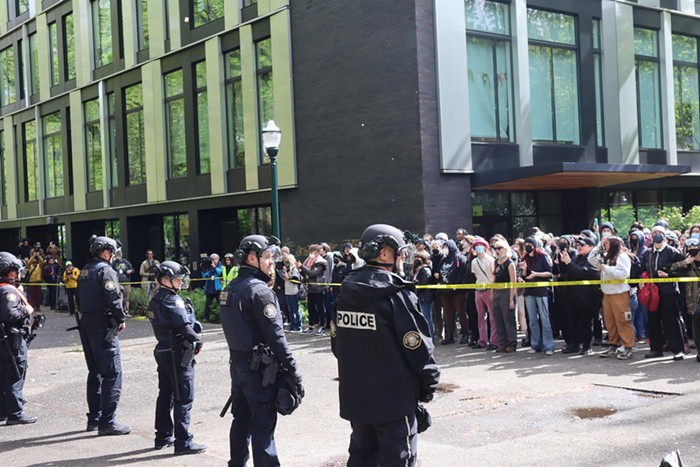Providence nurses across the state remain on the picket line today, claiming the hospital system is illegally locking them out of work following the conclusion of their three-day strike yesterday.
According to the Oregon Nurses Association (ONA), nurses striking at six hospitals across Oregon provided notice to Providence that they would return to work at six o’clock this morning—only for Providence to respond that they would return to work starting on Sunday.
According to reporting by OPB, Providence offered replacement nurses five-day contracts in spite of the fact that their own nurses planned to return to work on Friday. The union said some nurses were invited back to work starting today, but not on their regular schedules.
“ONA-represented nurses are encouraged to not cross the picket line and we will vigorously defend any nurse who chooses not to cross the picket line,” the union said in a statement.
ONA says it is filing an Unfair Labor Practice (ULP) charge with the National Labor Relations Board (NLRB) and will seek backpay for its nurses. ONA nurses are planning to picket again on Saturday.
The lockout allegation is just one of the current points of conflict between the union and Providence, which have been locked in contentious contract negotiations for much of the year.
The ONA also alleged Friday that Providence is violating the state’s safe staffing law after the executive director of the Oregon Health Authority provided an update on the state of ongoing investigations into ONA complaints against the hospital.
On Thursday, Sejal Hathi, the director of the Oregon Health Authority (OHA), sent a letter to both the executive director of ONA and the executive vice president of external affairs at the Oregon Hospital Association, detailing the status of investigations into ONA complaints about staffing levels.
Hathi’s letter doesn’t mention Providence, but ONA wrote that “the Oregon Health Authority (OHA) has confirmed violations of Oregon’s nurse staffing law by Providence.” The hospital rejected the ONA’s characterization of the letter, calling the union’s statement “truth-twisting.”
“Providence has taken implementation of the new law seriously—and that’s proven by the fact that we have all our Providence Oregon nurse staffing plans submitted and posted,” Jennifer Gentry, the chief nursing officer for Providence’s Central Division, said in a statement.
The sparring over staffing levels comes on the heels of a three-day strike by Providence nurses across six Oregon hospitals earlier in the week.
The volume of complaints the OHA has received regarding staffing following the implementation of a new state staffing law at the beginning of June has been remarkable: OHA received 556 complaints between June 1 and June 19 compared to just 282 complaints from September of last year through the end of May.
As a result, Hathi wrote, the agency’s investigative resources are under stress.
“Due to the influx of recent complaints, program resources are necessarily being diverted from completing investigations to triaging complaints,” Hathi wrote. “OHA is actively evaluating what additional staffing resources from across the agency can be repurposed to support investigations and, to aid transparency, will also be erecting a public dashboard to track progress.”
The OHA currently has 33 open investigations addressing 122 complaints across 23 hospitals, and Hathi wrote that the results of several of those investigations are now overdue.
Staffing has been a major source of conflict in stalled contract negotiations between Providence and nurses at six hospitals across the state that saw work stoppages this week, with much of the concern centering around the implementation of the new staffing law which the ONA has accused the hospital of trying to “undermine.”
Last year, Oregon became just the second state in the country to adopt a safe staffing law for nurses with the passage of HB 2697. The law, which took effect this month, limits the number of patients who can be assigned to each nurse and banned the practice of buddy breaks, wherein nurses would cover their colleagues’ patient load when they took breaks.
The passage of the law, which was enthusiastically backed by a coalition of unions that formerly included ONA, was heralded as a significant achievement for both nurses and patients.
Its implementation, however, has created tension. Nurses at Providence St. Vincent Medical Center in Portland told the Mercury this week that their hospital has begun assigning nurses the maximum number of patients allowable without taking into account how ill those patients are, leaving them with little time to adequately care for them.
Ongoing issues over staffing levels could be resolved in hospital staffing committees, but the union has asserted that Providence has attempted to push through staffing plans that were never approved by nurse staffing committees in violation of current law.
“Providence submitted staffing plans to OHA for approval that were never agreed upon by nurses and were unilaterally adopted by management without the required approval from the nurse staffing committee,” ONA wrote. “According to OHA, this action violates Oregon’s staffing law, as ONA represented nurses have been claiming.”
ONA has also alleged that Providence’s contract offers have sought to eliminate entirely the legal requirement for staffing committees to approve nurse staffing plans, which ONA opposes.
In her letter, Hathi confirmed that “the NSC (nurse staffing committee) would need to vote to approve the amended NSP (nurse staffing plan) or new NSP with a quorum of members present and by a majority vote with an equal number of direct care staff and managers voting, in order for OHA to consider a plan to be adopted.”
The conflict over staffing levels and procedures was one of the major issues that drove some 3,000 Providence nurses to strike for three days earlier this week—the largest nurses’ strike in Oregon in decades.
Each of the six hospitals that saw nurses strike must reach their own contract agreement with the hospital. It remains to be seen when the sides, which were in federal mediation earlier this year at St. Vincent’s, will next meet at the bargaining table.




















